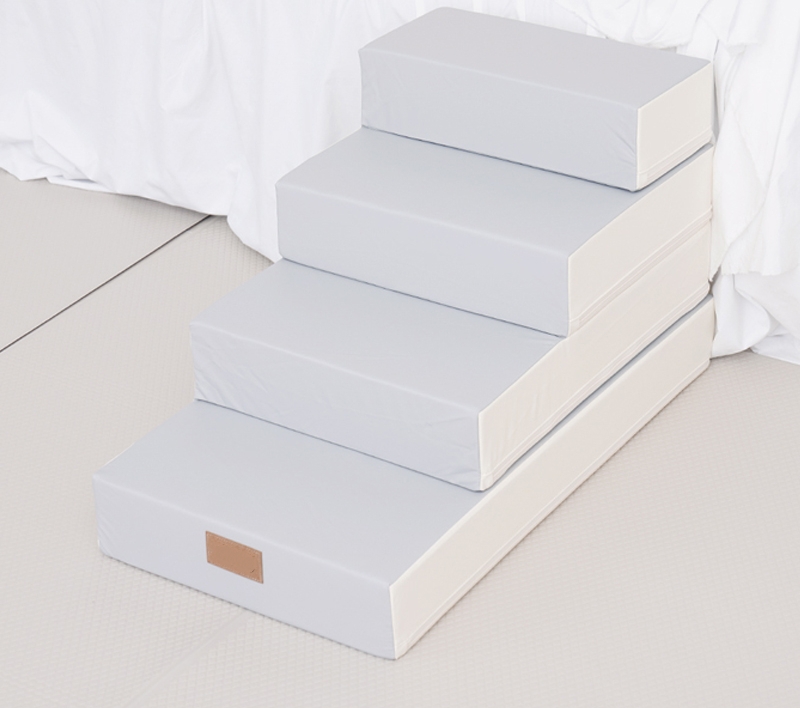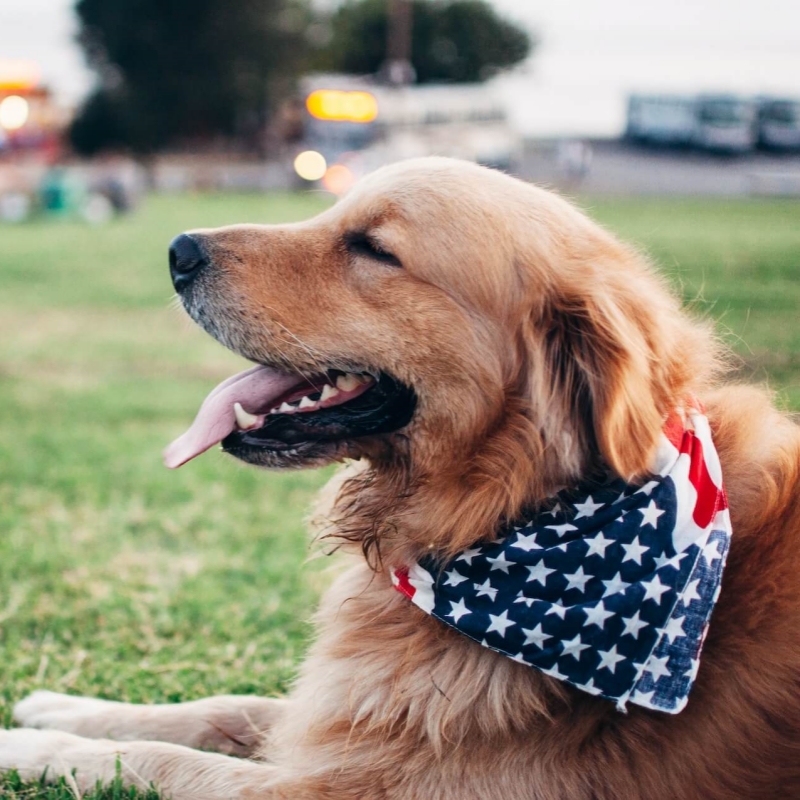
Ramp vs. Stairs: Which is the Best Solution for Your Dog’s Bedtime Routine?
For many dog owners, watching their furry friend struggle to climb onto a bed or couch can be heart-wrenching. As our pets age or face

Getting the properly sized dog ramp is crucial for providing safe and easy access to beds and furniture. Ramps that are too steep or too unstable can make dogs hesitant to use them.
Follow this comprehensive guide to find the ideal dog ramp dimensions for your pet and setup.

The very first step is accurately measuring how high your dog’s bed sits off the floor:
First, position the bed firmly against a wall or into a corner to prevent wobbling when measuring vertical height. Pushing the bed flush will ensure you get an accurate stationary reading.
Make sure to use steel retractable measuring tape rather than cloth tape to get the most precise measurement possible. Avoid cloth tapes that can stretch or sag.
When taking the measurement, remember to include the total compressed mattress thickness, not just the bed frame height. This gives true total vertical height dogs will have to traverse to get in and out of bed.
If bed legs sit directly on the floor, simply measure from the ground floor to the top surface where your dog steps onto the mattress. But if the bed frame legs elevate the base significantly, make sure to factor in this added bed leg height as well.
Be sure to repeat the height measurement process with the bed positioned on all surfaces dogs will need to access, such as bare floors, carpets, rugs and hardwood. Bed heights may vary slightly based on factors like flooring material compressions.
Weight depressions will cause beds and mattresses to sink lower when dogs lay on them. Measure the height from the floor to the mattress surface both with and without your dog’s weight on it to quantify sinking. Add a few extra inches to the ramp size to compensate.
Once you have firmly established your exact bed height, the optimal recommended ramp length to reach that bed can be estimated:
For gradually sloped ergonomic ramps, veterinarians often recommend following the general rule of thumb that ramps should have a horizontal length of approximately 4 times the vertical rise of the bed height. This results in a gentle incline angle of around 15-20 degrees.
As an example, if your bed measures 24 inches tall off the ground, the recommended ramp length would be roughly 24 inches (bed height) * 4 = 96 inches total ramp length. Converted to feet, that equals an 8-foot ramp.
For very large breed dogs like Mastiffs or Great Danes, use a more gradual ratio of 1:5 instead for a shallower and easier-to-climb slope. On the other hand, smaller dogs can potentially handle slightly steeper angles of 1:3 ratios. Also factor in your dog’s age, joint health and mobility to find lengths they can handle.
Reputable ramp brands often provide sizing guidance charts and calculators recommending which specific ramp sizes and capacities pair best with certain bed heights. Cross-reference their ramp selection tools as well.
Beyond just the overall ramp length, the incline angle of the slope also matters significantly for ease of use:
Most veterinarians recommend ramp angles between 15-30 degrees to avoid excess stress on dog joints during climbing. Limit angles to 20 degrees or shallower for dogs with orthopedic conditions or who tire easily.
There are a variety of digital angle finder tools and smartphone apps that can precisely measure the true slope of ramps down to decimal points. For cheaper DIY ramps, a simple protractor works too.
Test out sample ramps with your dog and adjust inclines to find angles they can readily ascend and descend without hesitation, stress or obvious straining. Let their comfort be the deciding factor.
Try to keep ramp angles symmetrical on both the top and bottom ends of the ramp. Having identical inclines on each end helps dogs grasp and become accustomed to the ramp slope more quickly.
For dog beds that sit especially far off the ground over 30 inches tall, some extra ramp considerations come into play:
Beds elevated over 30 inches or higher generally require extended-length ramps exceeding 10 feet to maintain the recommended slope ratios and angle thresholds. Take measurements to confirm you have sufficient linear run space available where you plan to set up the ramp.
Consider introducing intermediate 25-50% stair landings or platforms along the ramp length to break up very long uninterrupted runs. This helps avoid making slopes overly steep. Just be sure landings are also large enough for your dog.
Multi-directional switchback ramps with slight turns can help save space when working with cramped floors and vertical limitations. But verify your dog is agile enough to handle cornering on the turns comfortably.
For very tall beds, integrating just a few initial steps at the base before transitioning to the main ramp run helps further reduce inclines. But ensure step heights are low enough for your dog to traverse.
Take an honest assessment of your dog’s current mobility, leg and joint health before committing to significant ramp length and slope requirements. Consult your veterinarian on what they can reasonably handle.

In addition to ramp dimensions, the weight-bearing cargo capacity must also be factored in when selecting ramps:
Carefully verify that ramps are rated and tested to safely support your dog’s full adult weight. This is especially critical for giant breeds exceeding 100 lbs. Avoid ramps with low weight limits that cannot handle repeat use by heavy dogs.
Try to avoid flimsy thin folding ramps that tend to flex and bow downward when walked on. Seek out ramp platforms made of solid dense materials that feel very rigid and stable underfoot when tested.
For extra security, anchor down ramps in place using included hardware if available. Anchors help prevent shifting on slippery hard floors and keep ramps firmly in position during repeated use.
Closely inspect ramp treading and ensure there is an adequate non-slip texture for paws, whether it’s cross-hatched grip tape, carpeted treads or high-grip rubberized surfaces. Traction is key.
To further supplement traction, it can be helpful to add your own anti-slip elements like grip tape, yoga mats or artificial turf coverings on the ramp tread area for extra security.
Folding and multi-panel ramps offer conveniences like easier storage and transportation, but also have some caveats to be aware of:
Since assembled multi-piece ramps are inherently weaker than solid one-piece ramps, carefully test the true maximum weight capacity when segments are fully joined together. Avoid trusting packaging claims alone.
When assembled, walk on folding ramp sections to check for any flexing, instability, looseness or wobbling at the connecting joints which could indicate compromised structural integrity.
Examine to ensure gaps between folded ramp segments are not large enough for nails or paws to partially catch when dogs walk across transition areas. Gaps can trip dogs.
Make sure folding ramps are realistically light and compact enough when collapsed to actually provide portability benefits. If ramps are heavy or bulky when folded, it negates the advantage of their takedown design.
Consider where ramps will be stored when not in use. Measure folded dimensions to ensure they will fit the intended storage space without excess clutter or trip hazards from unwieldy folded ramps.
Little dogs generally need ramps designed with smaller toy breeds in mind:
Smaller paw pad contact areas mean less natural traction on ramps. So grippy treads and side rails are especially important for preventing slips.
Typically, small dog legs tire more quickly on inclines. Opt for shallower angles around 15 degrees to reduce strain on their joints.
Consider ramps with paw-braking flaps that can more gently slow descent speeds for light dogs. Some ramps have slat designs that require deliberate paw placement.
On open-tread ramps, look for very tight spacing between slats or nubs that prevent small paw extremities from poking through and getting caught.
The low profile of some small ramps makes them prone to catching gusts of wind if used outdoors. Weigh down with sandbags or secure with tent stakes when needed.

Based on pet owner reviews, durability, value and designs, here are 5 of the top recommended dog ramps for safely accessing beds and furniture:
PawClimb Ramp Lightweight, ergonomic design with anti-slip features, ensuring pet safety and elegance up to 200 lbs.
Pet Gear Tri-Fold Ramp Ultra lightweight 3-panel folding ramp rated for 200 lbs. Features plush carpet tread and convenient carry handle perfect for small spaces.
PetSafe Solvit PupSTEP Plus Budget-friendly wooden ramp supporting up to 500 lbs. Side rails prevent slips off the edge. Has cross-hatched grip tape for added traction.
PetSTEP Original Polyfold Durable polypropylene plastic ramp in two folding sections. Affordable at under $100. The textured grooved surface gives traction.
Gunner Grip Steps Ramp Heavy duty single piece ramp that supports 350 lbs. The deep-treaded stepping grid pattern accommodates mobility-impaired dogs well.
Using these guidelines helps determine the ideal ramp specifications for your dog based on health, bed setup, and home environment. With the properly sized ramp, dogs can comfortably and safely access their favorite lounging spots.

For many dog owners, watching their furry friend struggle to climb onto a bed or couch can be heart-wrenching. As our pets age or face

For many pet owners, a dog ramp is more than just a convenience—it’s a lifeline, ensuring our furry friends can comfortably access their favorite lounging

In today’s design-conscious world, every piece of furniture and accessory in our homes is a reflection of our personal style. So, why should our pet

Bringing home a new dog ramp for your pup’s bed takes some initial training so they learn how to use it properly. Ramps are unfamiliar

For many dog owners, watching their furry friend struggle to climb onto a bed or couch can be heart-wrenching. As our pets age or face

For many pet owners, a dog ramp is more than just a convenience—it’s a lifeline, ensuring our furry friends can comfortably access their favorite lounging

In today’s design-conscious world, every piece of furniture and accessory in our homes is a reflection of our personal style. So, why should our pet

Bringing home a new dog ramp for your pup’s bed takes some initial training so they learn how to use it properly. Ramps are unfamiliar
Copyright © 2024 pawclimbdogbedramp. All Rights Reserved.